The Cambridge History of Japan, Vol. 3: Medieval Japan
Подождите немного. Документ загружается.

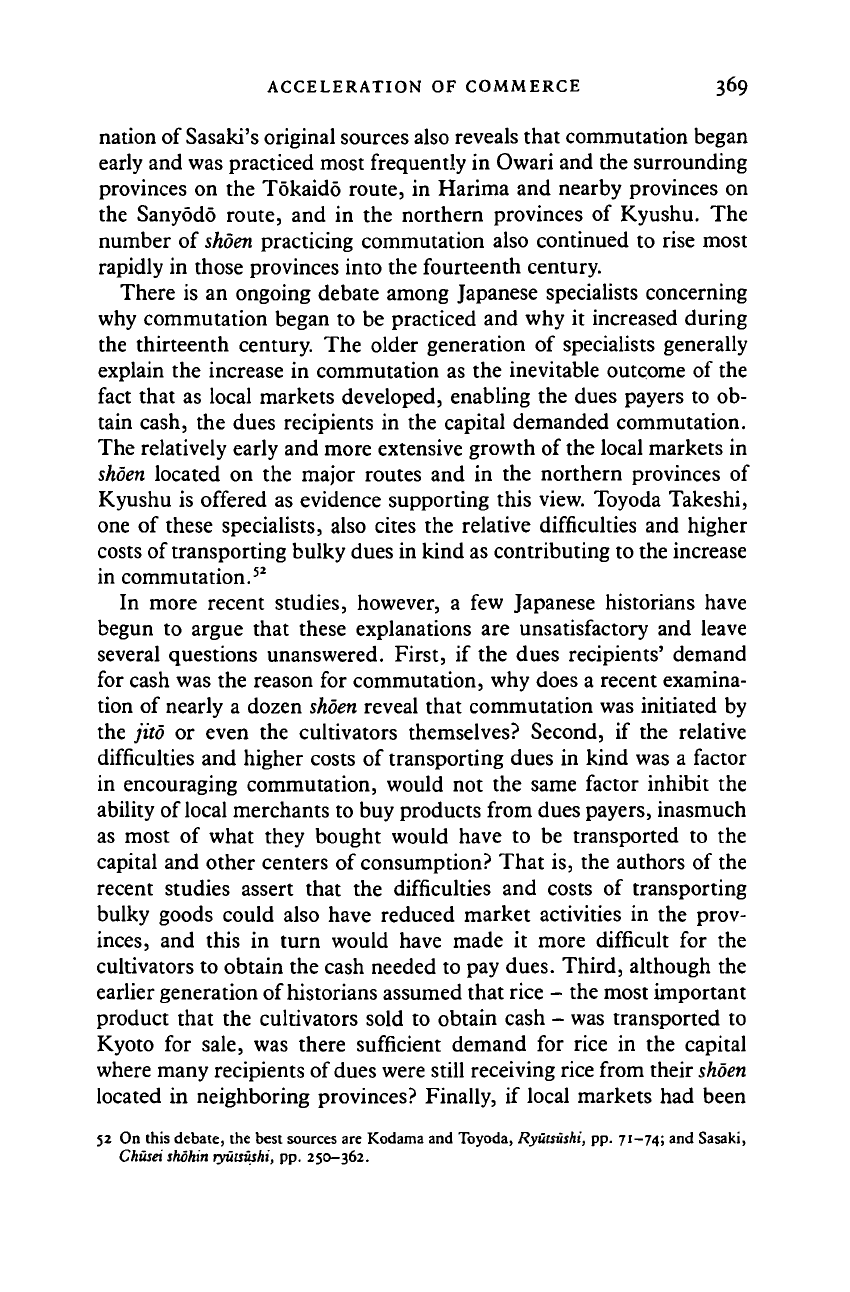
ACCELERATION OF COMMERCE 369
nation of Sasaki's original sources also reveals that commutation began
early and was practiced most frequently in Owari and the surrounding
provinces on the Tokaido route, in Harima and nearby provinces on
the Sanyodo route, and in the northern provinces of Kyushu. The
number of
shoen
practicing commutation also continued to rise most
rapidly in those provinces into the fourteenth century.
There is an ongoing debate among Japanese specialists concerning
why commutation began to be practiced and why it increased during
the thirteenth century. The older generation of specialists generally
explain the increase in commutation as the inevitable outcome of the
fact that as local markets developed, enabling the dues payers to ob-
tain cash, the dues recipients in the capital demanded commutation.
The relatively early and more extensive growth of the local markets in
shoen located on the major routes and in the northern provinces of
Kyushu is offered as evidence supporting this view. Toyoda Takeshi,
one of these specialists, also cites the relative difficulties and higher
costs of transporting bulky dues in kind as contributing to the increase
in commutation.
52
In more recent studies, however, a few Japanese historians have
begun to argue that these explanations are unsatisfactory and leave
several questions unanswered. First, if the dues recipients' demand
for cash was the reason for commutation, why does a recent examina-
tion of nearly a dozen shoen reveal that commutation was initiated by
the jito or even the cultivators themselves? Second, if the relative
difficulties and higher costs of transporting dues in kind was a factor
in encouraging commutation, would not the same factor inhibit the
ability of local merchants to buy products from dues payers, inasmuch
as most of what they bought would have to be transported to the
capital and other centers of consumption? That is, the authors of the
recent studies assert that the difficulties and costs of transporting
bulky goods could also have reduced market activities in the prov-
inces,
and this in turn would have made it more difficult for the
cultivators to obtain the cash needed to pay dues. Third, although the
earlier generation of historians assumed that rice - the most important
product that the cultivators sold to obtain cash - was transported to
Kyoto for sale, was there sufficient demand for rice in the capital
where many recipients of dues were still receiving rice from their
shoen
located in neighboring provinces? Finally, if local markets had been
52 On this debate, the best sources are Kodama and Toyoda, Ryutsushi, pp. 71-74; and Sasaki,
Chusei shohin ryutsushi, pp. 250-362.
Cambridge Histories Online © Cambridge University Press, 2008
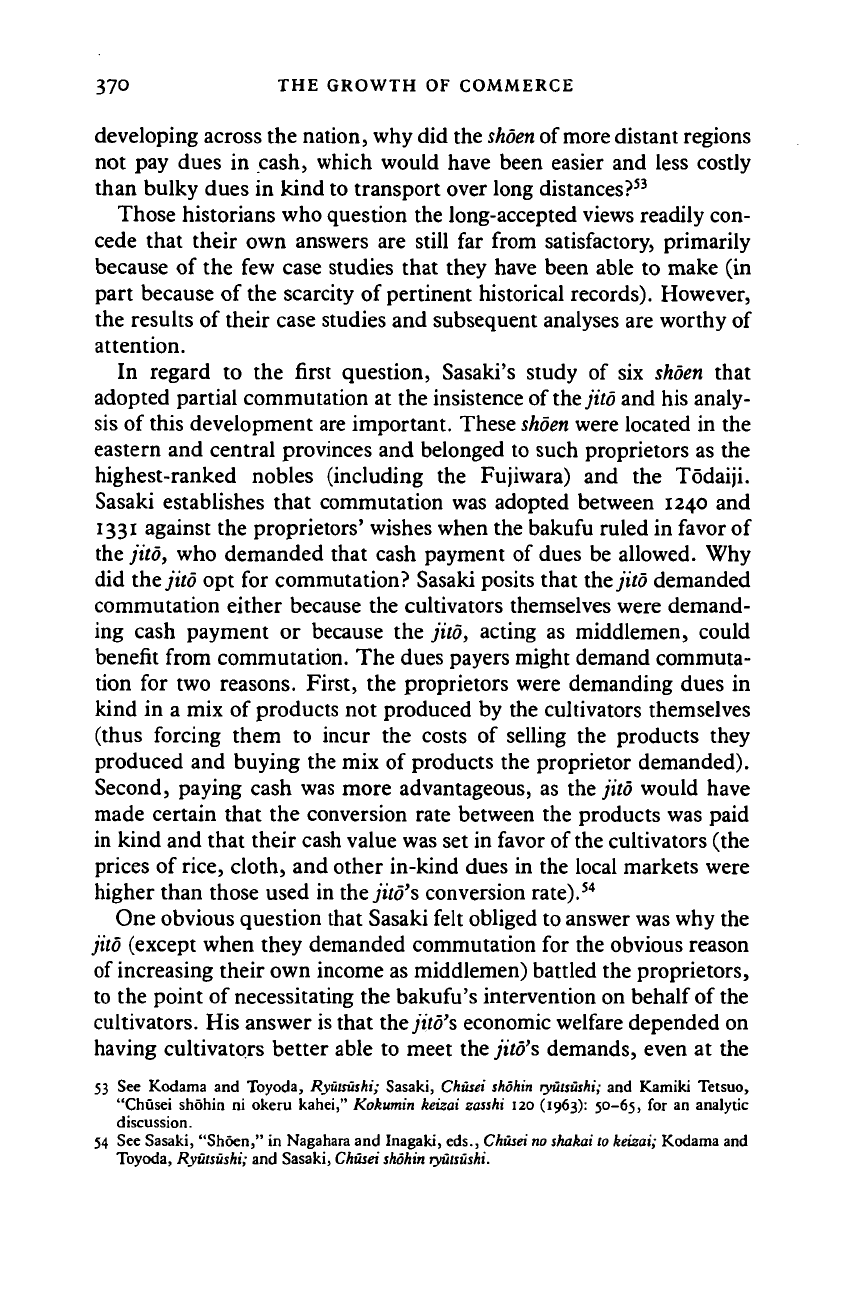
370 THE GROWTH OF COMMERCE
developing across the nation, why did the
shoen
of more distant regions
not pay dues in cash, which would have been easier and less costly
than bulky dues in kind to transport over long distances?
53
Those historians who question the long-accepted views readily con-
cede that their own answers are still far from satisfactory, primarily
because of the few case studies that they have been able to make (in
part because of the scarcity of pertinent historical records). However,
the results of their case studies and subsequent analyses are worthy of
attention.
In regard to the first question, Sasaki's study of six
shoen
that
adopted partial commutation at the insistence of the jito and his analy-
sis of this development are important. These
shoen
were located in the
eastern and central provinces and belonged to such proprietors as the
highest-ranked nobles (including the Fujiwara) and the Todaiji.
Sasaki establishes that commutation was adopted between 1240 and
1331 against the proprietors' wishes when the bakufu ruled in favor of
the jito, who demanded that cash payment of dues be allowed. Why
did the jito opt for commutation? Sasaki posits that the jito demanded
commutation either because the cultivators themselves were demand-
ing cash payment or because the jito, acting as middlemen, could
benefit from commutation. The dues payers might demand commuta-
tion for two reasons. First, the proprietors were demanding dues in
kind in a mix of products not produced by the cultivators themselves
(thus forcing them to incur the costs of selling the products they
produced and buying the mix of products the proprietor demanded).
Second, paying cash was more advantageous, as the jito would have
made certain that the conversion rate between the products was paid
in kind and that their cash value was set in favor of the cultivators (the
prices of rice, cloth, and other in-kind dues in the local markets were
higher than those used in there's conversion rate).
54
One obvious question that Sasaki felt obliged to answer was why the
jito (except when they demanded commutation for the obvious reason
of increasing their own income as middlemen) battled the proprietors,
to the point of necessitating the bakufu's intervention on behalf of the
cultivators. His answer is that the^tfc's economic welfare depended on
having cultivators better able to meet the jito's demands, even at the
53 See Kodama and Toyoda, Ryutsushi; Sasaki, Chusei
shohin
ryutsushi;
and Kamiki Tetsuo,
"Chusei shohin ni okeru kahei," Kokumin keizai zasshi 120 (1963): 50-65, for an analytic
discussion.
54 See Sasaki, "Shoen," in Nagahara and Inagaki, eds.,
Chusei no
shakai to keizai; Kodama and
Toyoda, Ryutsushi; and Sasaki,
Chusei shohin
ryutsushi.
Cambridge Histories Online © Cambridge University Press, 2008
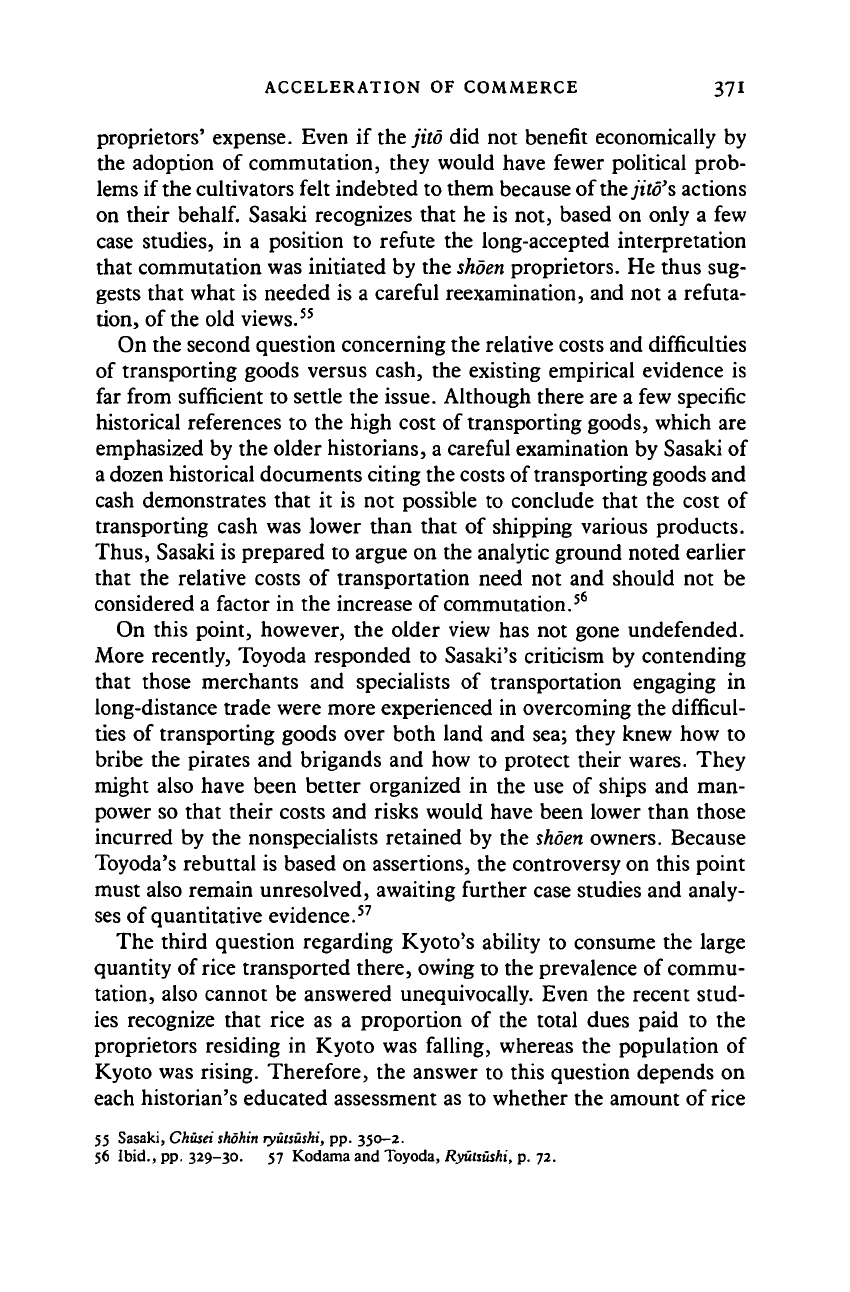
ACCELERATION OF COMMERCE 37I
proprietors' expense. Even if the jito did not benefit economically by
the adoption of commutation, they would have fewer political prob-
lems if the cultivators felt indebted to them because of the jito's actions
on their
behalf.
Sasaki recognizes that he is not, based on only a few
case studies, in a position to refute the long-accepted interpretation
that commutation was initiated by the
shoen
proprietors. He thus sug-
gests that what is needed is a careful reexamination, and not a refuta-
tion, of the old views.
55
On the second question concerning the relative costs and difficulties
of transporting goods versus cash, the existing empirical evidence is
far from sufficient to settle the issue. Although there are a few specific
historical references to the high cost of transporting goods, which are
emphasized by the older historians, a careful examination by Sasaki of
a dozen historical documents citing the costs of transporting goods and
cash demonstrates that it is not possible to conclude that the cost of
transporting cash was lower than that of shipping various products.
Thus,
Sasaki is prepared to argue on the analytic ground noted earlier
that the relative costs of transportation need not and should not be
considered a factor in the increase of commutation.
56
On this point, however, the older view has not gone undefended.
More recently, Toyoda responded to Sasaki's criticism by contending
that those merchants and specialists of transportation engaging in
long-distance trade were more experienced in overcoming the difficul-
ties of transporting goods over both land and sea; they knew how to
bribe the pirates and brigands and how to protect their wares. They
might also have been better organized in the use of ships and man-
power so that their costs and risks would have been lower than those
incurred by the nonspecialists retained by the shoen owners. Because
Toyoda's rebuttal is based on assertions, the controversy on this point
must also remain unresolved, awaiting further case studies and analy-
ses of quantitative evidence.
57
The third question regarding Kyoto's ability to consume the large
quantity of rice transported there, owing to the prevalence of commu-
tation, also cannot be answered unequivocally. Even the recent stud-
ies recognize that rice as a proportion of the total dues paid to the
proprietors residing in Kyoto was falling, whereas the population of
Kyoto was rising. Therefore, the answer to this question depends on
each historian's educated assessment as to whether the amount of rice
55 Sasaki, Chusei
shohin
ryutsushi, pp. 350-2.
56 Ibid., pp. 329-30. 57 Kodama and Toyoda, Ryutsushi, p. 72.
Cambridge Histories Online © Cambridge University Press, 2008
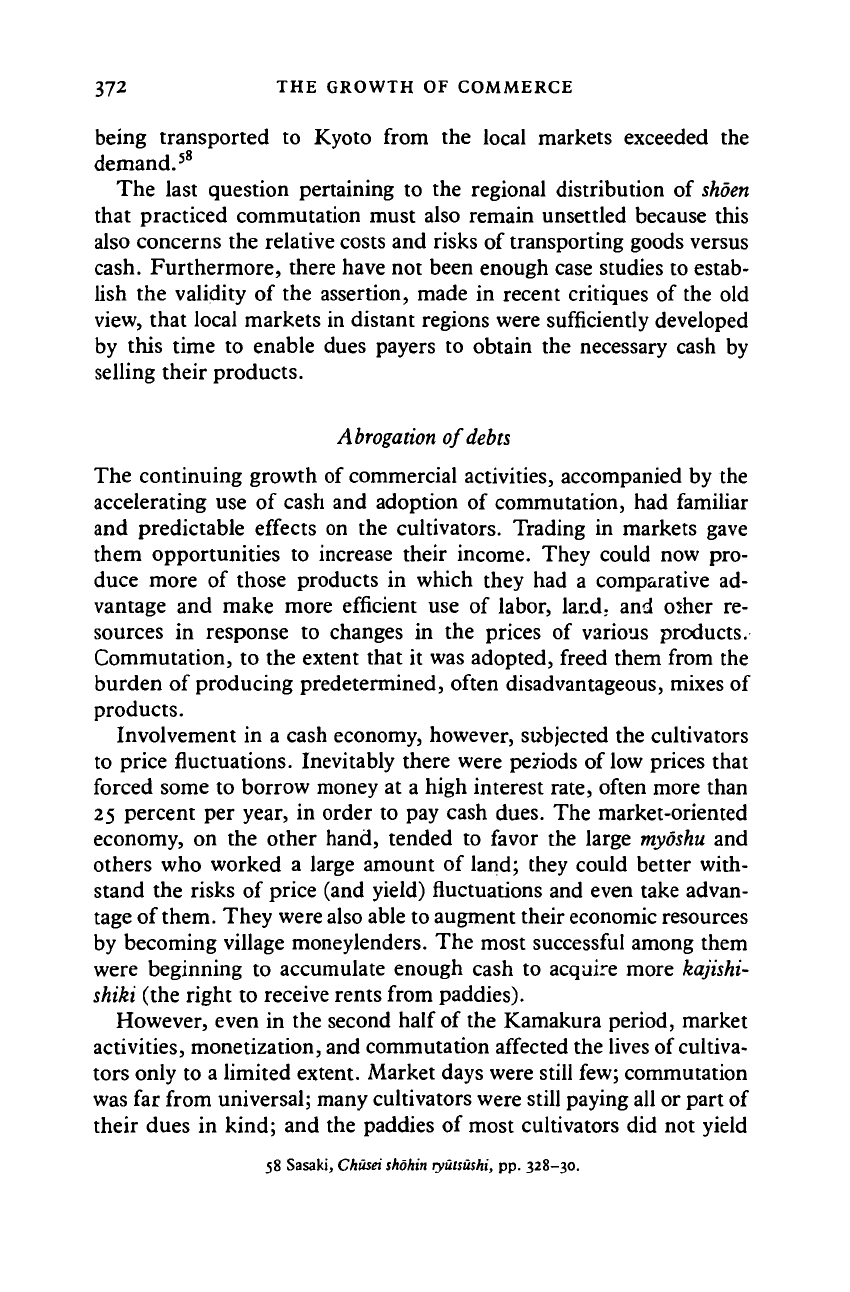
372 THE GROWTH OF COMMERCE
being transported to Kyoto from the local markets exceeded the
demand.
58
The last question pertaining to the regional distribution of
shoen
that practiced commutation must also remain unsettled because this
also concerns the relative costs and risks of transporting goods versus
cash. Furthermore, there have not been enough case studies to estab-
lish the validity of the assertion, made in recent critiques of the old
view, that local markets in distant regions were sufficiently developed
by this time to enable dues payers to obtain the necessary cash by
selling their products.
Abrogation of debts
The continuing growth of commercial activities, accompanied by the
accelerating use of cash and adoption of commutation, had familiar
and predictable effects on the cultivators. Trading in markets gave
them opportunities to increase their income. They could now pro-
duce more of those products in which they had a comparative ad-
vantage and make more efficient use of labor, land, and osher re-
sources in response to changes in the prices of various products.
Commutation, to the extent that it was adopted, freed them from the
burden of producing predetermined, often disadvantageous, mixes of
products.
Involvement in a cash economy, however, subjected the cultivators
to price fluctuations. Inevitably there were pe?iods of low prices that
forced some to borrow money at a high interest rate, often more than
25 percent per year, in order to pay cash dues. The market-oriented
economy, on the other hand, tended to favor the large
myoshu
and
others who worked a large amount of land; they could better with-
stand the risks of price (and yield) fluctuations and even take advan-
tage of them. They were also able to augment their economic resources
by becoming village moneylenders. The most successful among them
were beginning to accumulate enough cash to acquire more kajishi-
shiki (the right to receive rents from paddies).
However, even in the second half of the Kamakura period, market
activities, monetization, and commutation affected the lives of cultiva-
tors only to a limited extent. Market days were still few; commutation
was far from universal; many cultivators were still paying all or part of
their dues in kind; and the paddies of most cultivators did not yield
58 Sasaki,
Chiisei shohin
ryuisushi,
pp. 328-30.
Cambridge Histories Online © Cambridge University Press, 2008
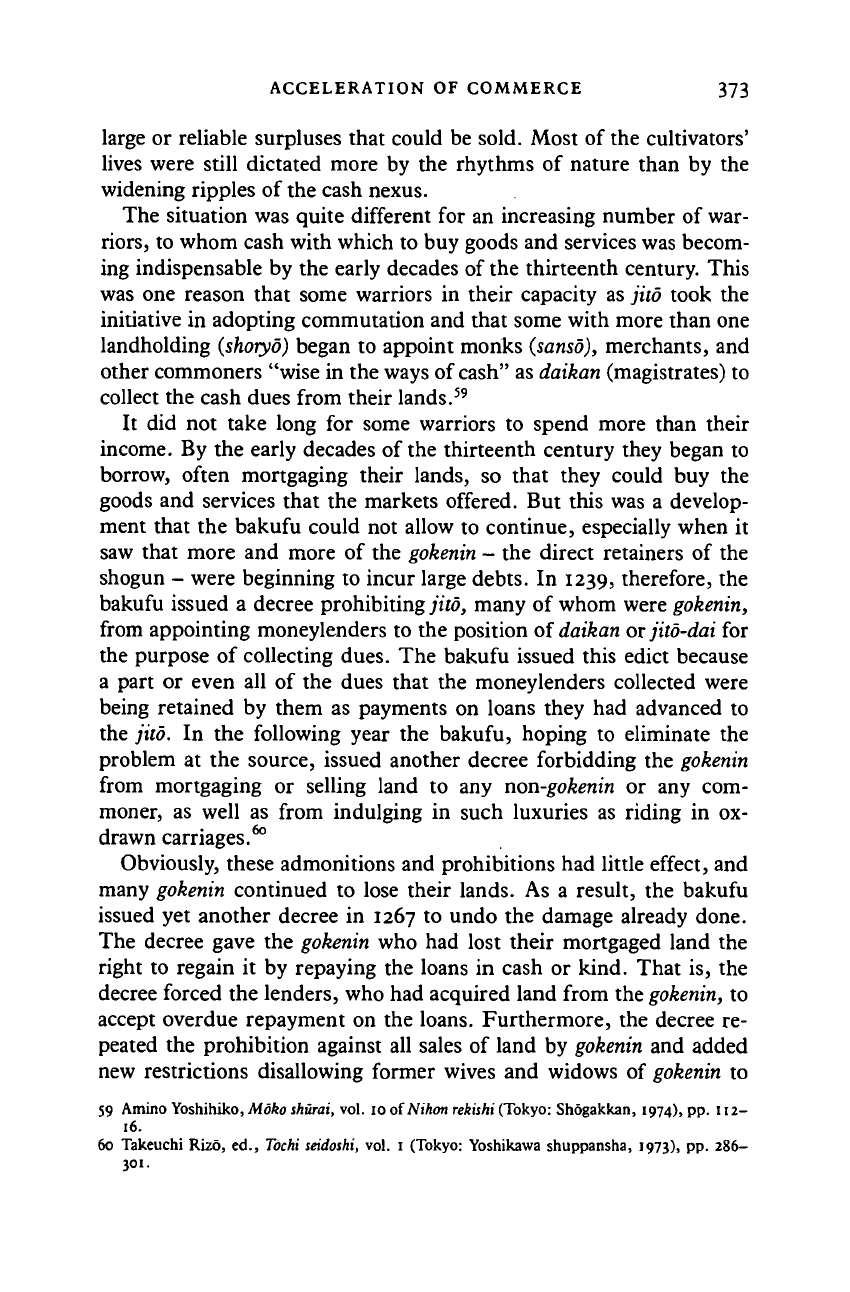
ACCELERATION OF COMMERCE 373
large or reliable surpluses that could be sold. Most of the cultivators'
lives were still dictated more by the rhythms of nature than by the
widening ripples of the cash nexus.
The situation was quite different for an increasing number of war-
riors,
to whom cash with which to buy goods and services was becom-
ing indispensable by the early decades of the thirteenth century. This
was one reason that some warriors in their capacity as jito took the
initiative in adopting commutation and that some with more than one
landholding (shotyo) began to appoint monks (sanso), merchants, and
other commoners "wise in the ways of cash" as daikan (magistrates) to
collect the cash dues from their lands.
59
It did not take long for some warriors to spend more than their
income. By the early decades of the thirteenth century they began to
borrow, often mortgaging their lands, so that they could buy the
goods and services that the markets offered. But this was a develop-
ment that the bakufu could not allow to continue, especially when it
saw that more and more of the gokenin - the direct retainers of the
shogun - were beginning to incur large debts. In 1239, therefore, the
bakufu issued a decree prohibiting jito, many of whom were gokenin,
from appointing moneylenders to the position of daikan or jito-dai for
the purpose of collecting dues. The bakufu issued this edict because
a part or even all of the dues that the moneylenders collected were
being retained by them as payments on loans they had advanced to
the jito. In the following year the bakufu, hoping to eliminate the
problem at the source, issued another decree forbidding the gokenin
from mortgaging or selling land to any non-gokenin or any com-
moner, as well as from indulging in such luxuries as riding in ox-
drawn carriages.
60
Obviously, these admonitions and prohibitions had little effect, and
many gokenin continued to lose their lands. As a result, the bakufu
issued yet another decree in 1267 to undo the damage already done.
The decree gave the gokenin who had lost their mortgaged land the
right to regain it by repaying the loans in cash or kind. That is, the
decree forced the lenders, who had acquired land from the gokenin, to
accept overdue repayment on the loans. Furthermore, the decree re-
peated the prohibition against all sales of land by gokenin and added
new restrictions disallowing former wives and widows of gokenin to
59 Amino Yoshihiko, Moko shurai, vol. 10 oiNihon rekishi (Tokyo: Shogakkan, 1974), pp. 112-
16.
60 Takeuchi Rizd, ed., Tochi seidoshi, vol. 1 (Tokyo: Yoshikawa shuppansha, 1973), pp. 286-
301.
Cambridge Histories Online © Cambridge University Press, 2008
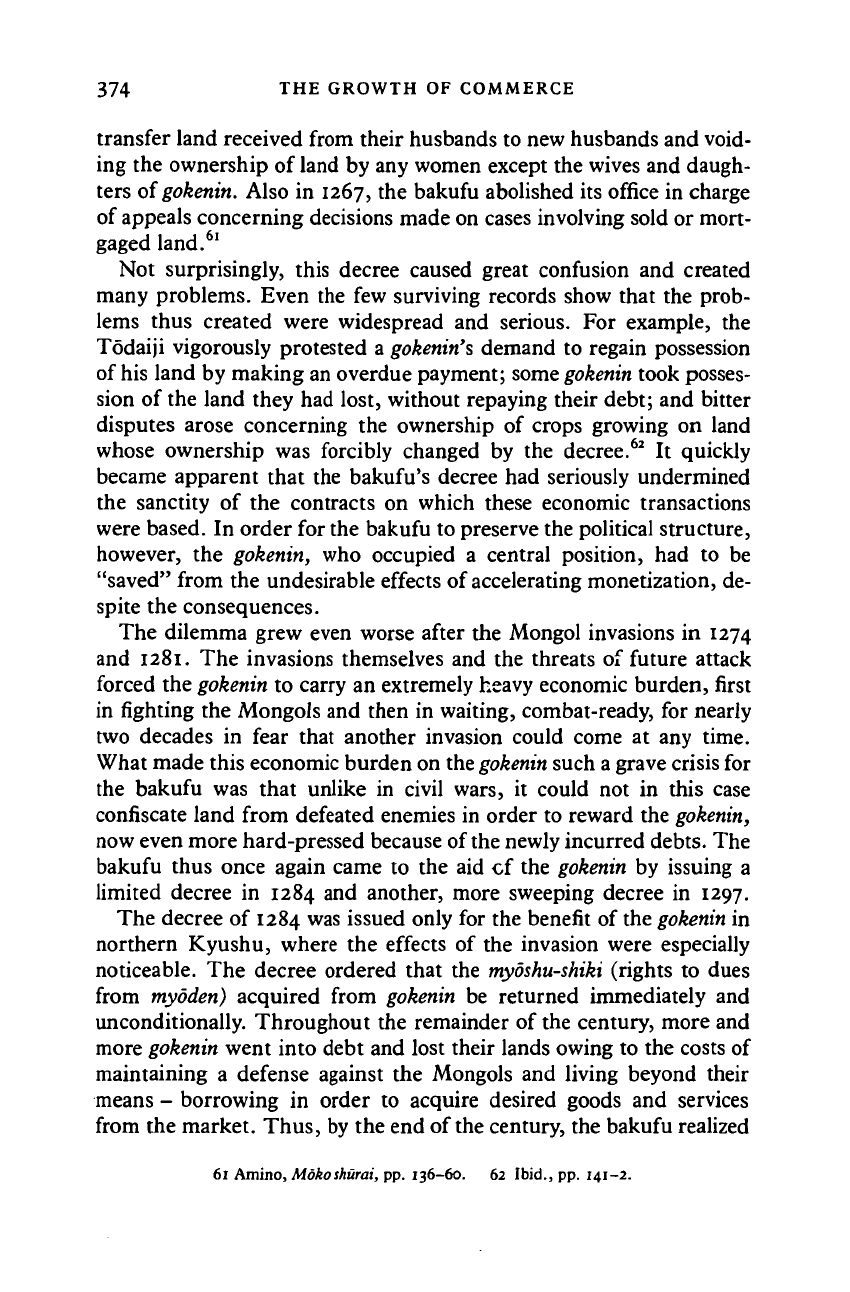
374 THE GROWTH OF COMMERCE
transfer land received from their husbands to new husbands and void-
ing the ownership of land by any women except the wives and daugh-
ters of
gokenin.
Also in 1267, the bakufu abolished its office in charge
of appeals concerning decisions made on cases involving sold or mort-
gaged land.
61
Not surprisingly, this decree caused great confusion and created
many problems. Even the few surviving records show that the prob-
lems thus created were widespread and serious. For example, the
Todaiji vigorously protested a
gokenin's
demand to regain possession
of his land by making an overdue payment; some
gokenin
took posses-
sion of the land they had lost, without repaying their debt; and bitter
disputes arose concerning the ownership of crops growing on land
whose ownership was forcibly changed by the decree.
62
It quickly
became apparent that the bakufu's decree had seriously undermined
the sanctity of the contracts on which these economic transactions
were based. In order for the bakufu to preserve the political structure,
however, the gokenin, who occupied a central position, had to be
"saved" from the undesirable effects of accelerating monetization, de-
spite the consequences.
The dilemma grew even worse after the Mongol invasions in 1274
and 1281. The invasions themselves and the threats of future attack
forced the
gokenin
to carry an extremely heavy economic burden, first
in fighting the Mongols and then in waiting, combat-ready, for nearly
two decades in fear that another invasion could come at any time.
What made this economic burden on the
gokenin
such a grave crisis for
the bakufu was that unlike in civil wars, it could not in this case
confiscate land from defeated enemies in order to reward the
gokenin,
now even more hard-pressed because of the newly incurred debts. The
bakufu thus once again came to the aid cf the
gokenin
by issuing a
limited decree in 1284 and another, more sweeping decree in 1297.
The decree of 1284 was issued only for the benefit of the
gokenin
in
northern Kyushu, where the effects of the invasion were especially
noticeable. The decree ordered that the
myoshu-shiki
(rights to dues
from myoden) acquired from
gokenin
be returned immediately and
unconditionally. Throughout the remainder of the century, more and
more
gokenin
went into debt and lost their lands owing to the costs of
maintaining a defense against the Mongols and living beyond their
means - borrowing in order to acquire desired goods and services
from the market. Thus, by the end of the century, the bakufu realized
61 Amino, Moko
shurai,
pp. 136-60. 62 Ibid., pp. 141-2.
Cambridge Histories Online © Cambridge University Press, 2008
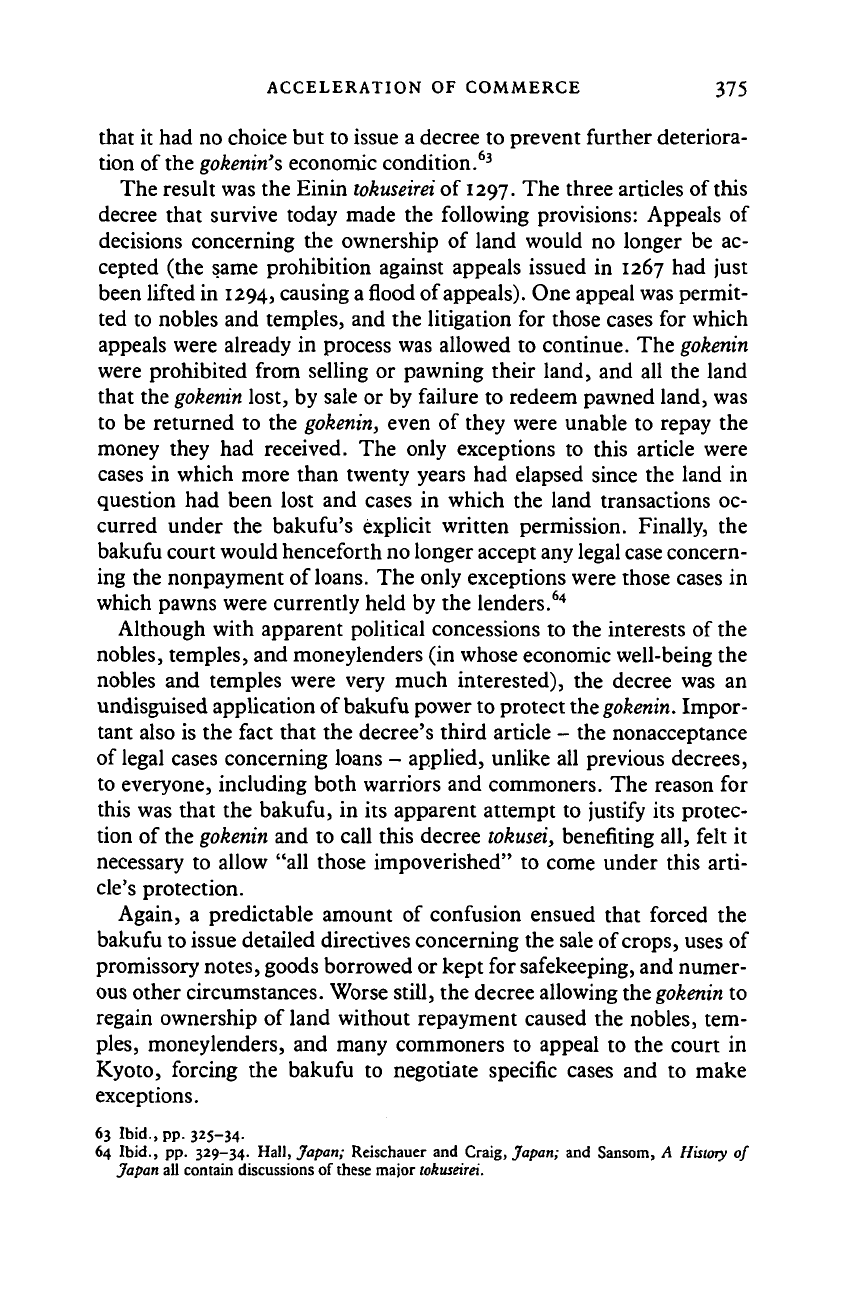
ACCELERATION OF COMMERCE 375
that it had no choice but to issue a decree to prevent further deteriora-
tion of the gokenin's economic condition.
63
The result was the Einin
tokuseirei
of 1297. The three articles of this
decree that survive today made the following provisions: Appeals of
decisions concerning the ownership of land would no longer be ac-
cepted (the same prohibition against appeals issued in 1267 had just
been lifted in 1294, causing a flood of
appeals).
One appeal was permit-
ted to nobles and temples, and the litigation for those cases for which
appeals were already in process was allowed to continue. The gokenin
were prohibited from selling or pawning their land, and all the land
that the gokenin lost, by sale or by failure to redeem pawned land, was
to be returned to the gokenin, even of they were unable to repay the
money they had received. The only exceptions to this article were
cases in which more than twenty years had elapsed since the land in
question had been lost and cases in which the land transactions oc-
curred under the bakufu's explicit written permission. Finally, the
bakufu court would henceforth no longer accept any legal case concern-
ing the nonpayment of
loans.
The only exceptions were those cases in
which pawns were currently held by the lenders.
64
Although with apparent political concessions to the interests of the
nobles, temples, and moneylenders (in whose economic well-being the
nobles and temples were very much interested), the decree was an
undisguised application of bakufu power to protect the gokenin. Impor-
tant also is the fact that the decree's third article - the nonacceptance
of legal cases concerning loans - applied, unlike all previous decrees,
to everyone, including both warriors and commoners. The reason for
this was that the bakufu, in its apparent attempt to justify its protec-
tion of the gokenin and to call this decree tokusei, benefiting all, felt it
necessary to allow "all those impoverished" to come under this arti-
cle's protection.
Again, a predictable amount of confusion ensued that forced the
bakufu to issue detailed directives concerning the sale of
crops,
uses of
promissory notes, goods borrowed or kept for safekeeping, and numer-
ous other circumstances. Worse still, the decree allowing the
gokenin
to
regain ownership of land without repayment caused the nobles, tem-
ples,
moneylenders, and many commoners to appeal to the court in
Kyoto, forcing the bakufu to negotiate specific cases and to make
exceptions.
63 Ibid., pp. 325-34.
64 Ibid., pp. 329-34. Hall, Japan; Reischauer and Craig, Japan; and Sansom, A History of
Japan all contain discussions of these major wkuseirei.
Cambridge Histories Online © Cambridge University Press, 2008
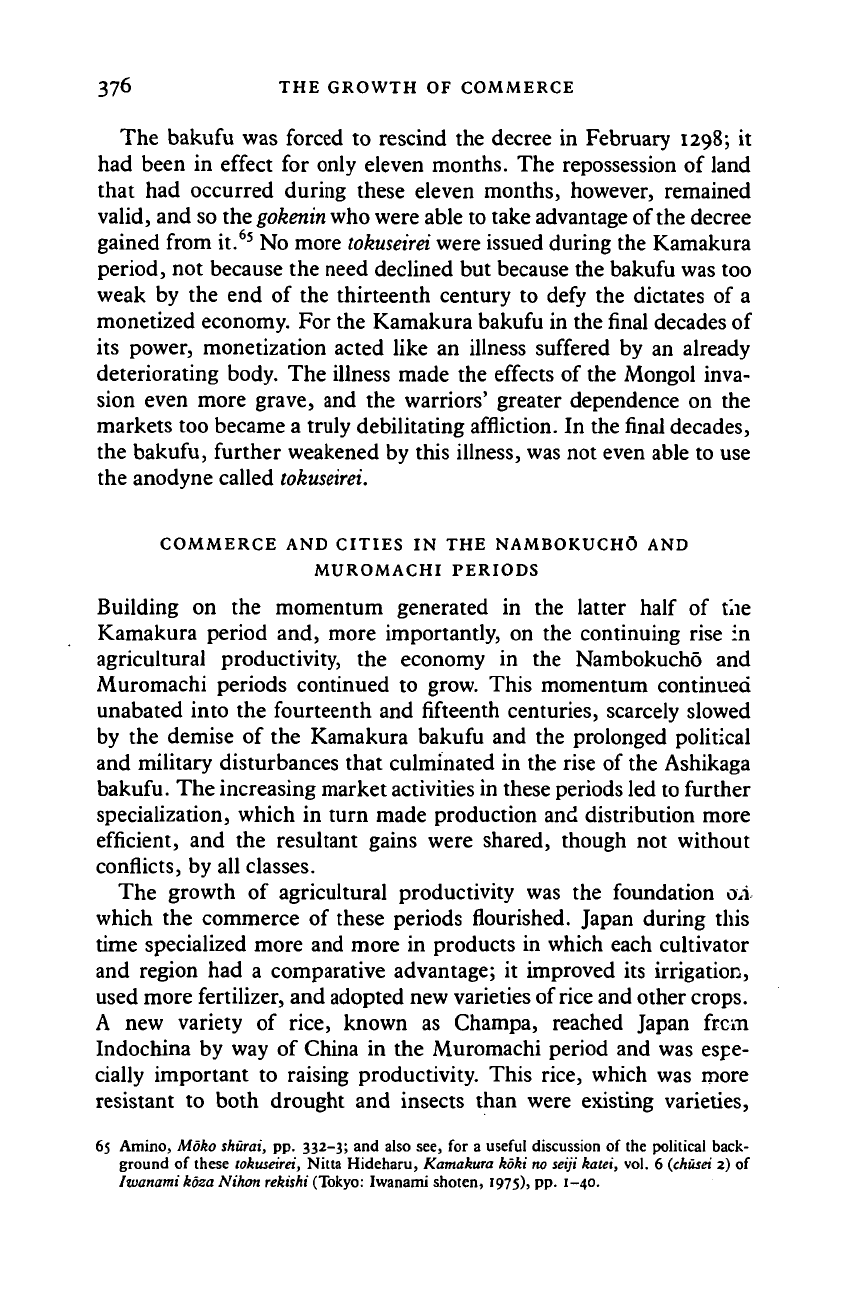
376 THE GROWTH OF COMMERCE
The bakufu was forced to rescind the decree in February 1298; it
had been in effect for only eleven months. The repossession of land
that had occurred during these eleven months, however, remained
valid, and so the
gokenin
who were able to take advantage of the decree
gained from it.
65
No more
tokuseirei
were issued during the Kamakura
period, not because the need declined but because the bakufu was too
weak by the end of the thirteenth century to defy the dictates of a
monetized economy. For the Kamakura bakufu in the final decades of
its power, monetization acted like an illness suffered by an already
deteriorating body. The illness made the effects of the Mongol inva-
sion even more grave, and the warriors' greater dependence on the
markets too became a truly debilitating affliction. In the
final
decades,
the bakufu, further weakened by this illness, was not even able to use
the anodyne called
tokuseirei.
COMMERCE AND CITIES IN THE NAMBOKUCHO AND
MUROMACHI PERIODS
Building on the momentum generated in the latter half of the
Kamakura period and, more importantly, on the continuing rise in
agricultural productivity, the economy in the Nambokucho and
Muromachi periods continued to grow. This momentum continued
unabated into the fourteenth and fifteenth centuries, scarcely slowed
by the demise of the Kamakura bakufu and the prolonged political
and military disturbances that culminated in the rise of the Ashikaga
bakufu. The increasing market activities in these periods led to further
specialization, which in turn made production and distribution more
efficient, and the resultant gains were shared, though not without
conflicts, by all classes.
The growth of agricultural productivity was the foundation OA
which the commerce of these periods flourished. Japan during this
ume specialized more and more in products in which each cultivator
and region had a comparative advantage; it improved its irrigation,
used more fertilizer, and adopted new varieties of
rice
and other crops.
A new variety of rice, known as Champa, reached Japan frcm
Indochina by way of China in the Muromachi period and was espe-
cially important to raising productivity. This rice, which was more
resistant to both drought and insects than were existing varieties,
65 Amino, Moko shurai, pp.
332-3;
and also see, for a useful discussion of the political back-
ground of these tokuseirei, Nitta Hideharu, Kamakura koki no seiji katei, vol. 6 (chusei 2) of
Iwanami koza Nihon rekishi (Tokyo: Iwanami shoten, 1975), pp. 1-40.
Cambridge Histories Online © Cambridge University Press, 2008
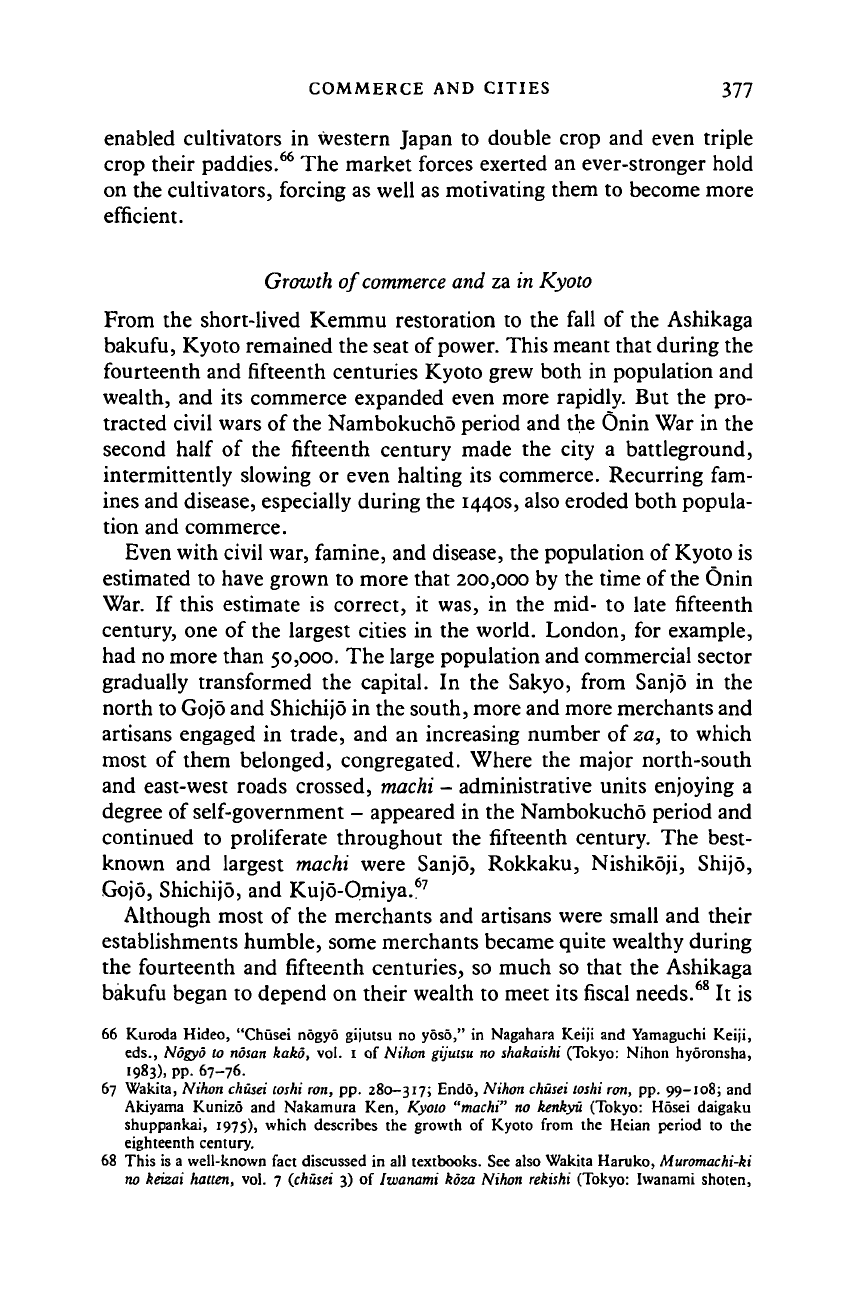
COMMERCE AND CITIES 377
enabled cultivators in western Japan to double crop and even triple
crop their paddies.
66
The market forces exerted an ever-stronger hold
on the cultivators, forcing as well as motivating them to become more
efficient.
Growth of
commerce
and za in Kyoto
From the short-lived Kemmu restoration to the fall of the Ashikaga
bakufu, Kyoto remained the seat of power. This meant that during the
fourteenth and fifteenth centuries Kyoto grew both in population and
wealth, and its commerce expanded even more rapidly. But the pro-
tracted civil wars of the Nambokucho period and the Onin War in the
second half of the fifteenth century made the city a battleground,
intermittently slowing or even halting its commerce. Recurring fam-
ines and disease, especially during the 1440s, also eroded both popula-
tion and commerce.
Even with civil war, famine, and disease, the population of Kyoto is
estimated to have grown to more that 200,000 by the time of the Onin
War. If this estimate is correct, it was, in the mid- to late fifteenth
century, one of the largest cities in the world. London, for example,
had no more than 50,000. The large population and commercial sector
gradually transformed the capital. In the Sakyo, from Sanjd in the
north to Gojo and Shichijo in the south, more and more merchants and
artisans engaged in trade, and an increasing number of za, to which
most of them belonged, congregated. Where the major north-south
and east-west roads crossed, machi - administrative units enjoying a
degree of self-government - appeared in the Nambokucho period and
continued to proliferate throughout the fifteenth century. The best-
known and largest machi were Sanjo, Rokkaku, Nishikoji, Shijo,
Gojo,
Shichijo, and Kujo-Omiya.
67
Although most of the merchants and artisans were small and their
establishments humble, some merchants became quite wealthy during
the fourteenth and fifteenth centuries, so much so that the Ashikaga
bakufu began to depend on their wealth to meet its fiscal needs.
68
It is
66 Kuroda Hideo, "Chusei nogyo gijutsu no yoso," in Nagahara Keiji and Yamaguchi Keiji,
eds.,
Nogyo to nosan kako, vol. i of Nihon gijuisu no shakaishi (Tokyo: Nihon hyoronsha,
1983).
PP- 67-76.
67 Wakita, Nihon chusei toshi ton, pp. 280-317; Endo, Nihon chusei toshi ron, pp. 99-108; and
Akiyama Kunizo and Nakamura Ken, Kyoto "machi" no kenkyu (Tokyo: Hosei daigaku
shuppankai, 1975), which describes the growth of Kyoto from the Heian period to the
eighteenth century.
68 This is a well-known fact discussed in all textbooks. See also Wakita Haruko, Muromachi-ki
no keizai hatten, vol. 7 (chusei 3) of Iwanami koza Nihon rekishi (Tokyo: Iwanami shoten,
Cambridge Histories Online © Cambridge University Press, 2008
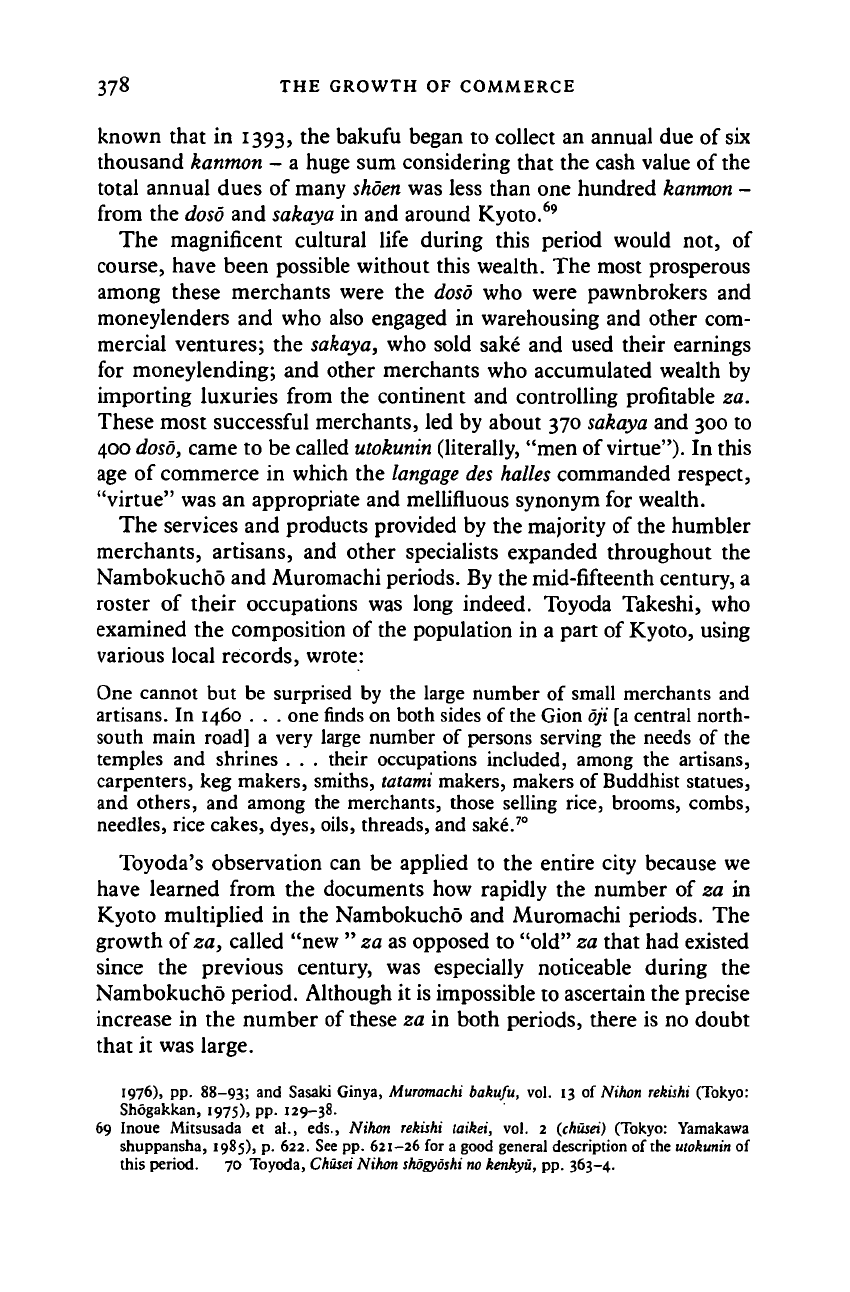
378 THE GROWTH OF COMMERCE
known that in 1393, the bakufu began to collect an annual due of six
thousand kanmon - a huge sum considering that the cash value of the
total annual dues of many shoen was less than one hundred kanmon -
from the doso and sakaya in and around Kyoto.
69
The magnificent cultural life during this period would not, of
course, have been possible without this wealth. The most prosperous
among these merchants were the doso who were pawnbrokers and
moneylenders and who also engaged in warehousing and other com-
mercial ventures; the sakaya, who sold sake and used their earnings
for money lending; and other merchants who accumulated wealth by
importing luxuries from the continent and controlling profitable za.
These most successful merchants, led by about 370 sakaya and 300 to
400 doso, came to be called utokunin (literally, "men of
virtue").
In this
age of commerce in which the
langage
des holies commanded respect,
"virtue" was an appropriate and mellifluous synonym for wealth.
The services and products provided by the majority of the humbler
merchants, artisans, and other specialists expanded throughout the
Nambokucho and Muromachi periods. By the mid-fifteenth century, a
roster of their occupations was long indeed. Toyoda Takeshi, who
examined the composition of the population in a part of Kyoto, using
various local records, wrote:
One cannot but be surprised by the large number of small merchants and
artisans. In 1460 . . . one
finds
on both sides of the Gion
071
[a central north-
south main road] a very large number of persons serving the needs of the
temples and shrines . . . their occupations included, among the artisans,
carpenters, keg makers, smiths,
tatami
makers, makers of Buddhist statues,
and others, and among the merchants, those selling rice, brooms, combs,
needles, rice cakes, dyes, oils, threads, and sakeV
0
Toyoda's observation can be applied to the entire city because we
have learned from the documents how rapidly the number of za in
Kyoto multiplied in the Nambokucho and Muromachi periods. The
growth of za, called "new " za as opposed to "old" za that had existed
since the previous century, was especially noticeable during the
Nambokucho period. Although it is impossible to ascertain the precise
increase in the number of these za in both periods, there is no doubt
that it was large.
1976),
pp. 88-93;
an
d Sasaki Ginya, Muromachi bakufu, vol. 13 of Nihon rekishi (Tokyo:
Shogakkan, 1975), pp. 129-38.
69 Inoue Micsusada et at., eds., Nihon rekishi taikei, vol. 2 (chusei) (Tokyo: Yamakawa
shuppansha, 1985), p. 622. See pp. 621-26 for a good general description of the
utokunin
of
this period. 70 Toyoda,
Chusei
Nihon
shogyoshi no
kenkyu, pp. 363-4.
Cambridge Histories Online © Cambridge University Press, 2008
